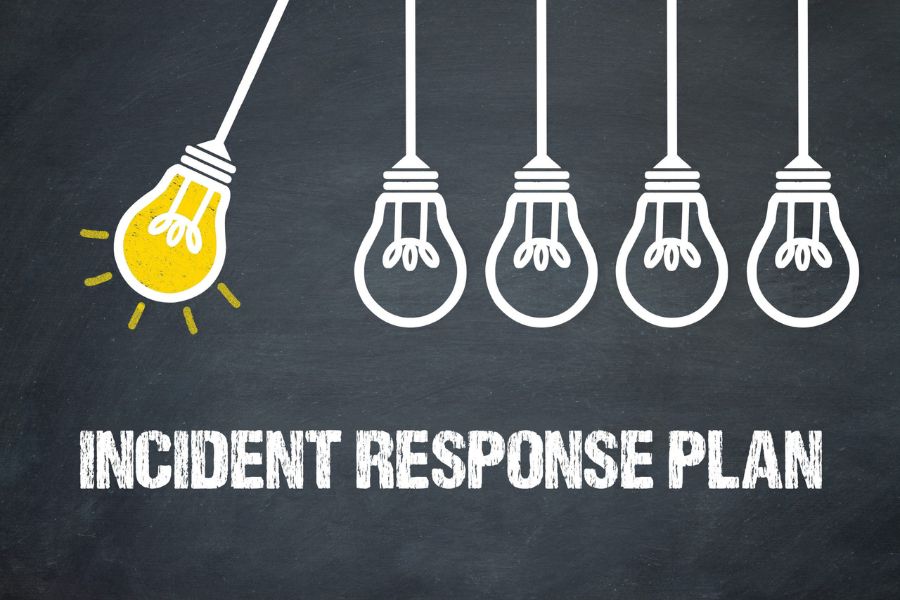Incident Response Plan (IRP) Testing
Is Your Team Ready to Handle a Possible Cyber Attack?

Boost Your Cyberdefenses with Incident Response Plan Testing
Performing incident response plan testing enables your organization to be better prepared to manage different types of threats, secure sensitive data, and minimize disruptions to business continuity. Testing an incident response plan is an ongoing process that requires regular review and updates to ensure it remains effective and relevant to the changing security landscape.
An important part of IT security planning includes incident response plan testing. An incident response plan helps your organization prepare for an incident like a data security breach, data leak, phishing attack, ransomware attack, or other cybersecurity threat or attack.
Why Choose CampusGuard for Your Incident Response Plan Testing?
Testing your incident response plan allows you to ensure that it is well-designed and will cover all steps to contain a security incident if one occurs.
Looking for expert-led incident response plan testing? CampusGuard delivers proven tabletop exercises. Here’s how we lead the way.
Access the Tabletop Exercise Checklist and Template
Is your organization ready to handle a cyber attack or emergency? Explore our Tabletop Exercise Checklist and Template to access:
- A Tabletop Exercise Pre-Planning Checklist to boost your success
- Sample exercise scenarios with realistic cyber incidents and recovery exercises
- A Tabletop Exercise Template that includes fillable form fields to document the detailed process
- Additional details to assist in planning your Tabletop Exercise
How Effectively Could You Respond to a Cyber Attack?
The best way to effectively test your incident response plan is with a tabletop exercise. A tabletop exercise is a type of incident response simulation or cyberattack simulation exercise that is used to practice and evaluate your team’s response to a hypothetical scenario, such as a data breach, without the need for significant resources.
These structured exercises allow participants to review and discuss their roles, responsibilities, and procedures in the context of a simulated real-life scenario without any actual risk to your organization.
Benefits of Incident Reponse Plan Testing
Engaging in incident response plan testing puts your plan to the test by identifying any gaps in your security defenses or operational processes. It’s always better to identify these deficiencies in a test environment and not wait for an actual cyber attack to occur before you discover how your team(s) will respond.
Here are the benefits of testing your Incident Response Plan:
-
Identifies gaps and deficiencies in your Incident Response Plan
By testing the incident response plan, your organization can identify any gaps or weaknesses in the plan. This can help you make necessary changes and improvements to the plan to ensure that it is effective and can manage any potential incidents. -
Improves response time and communication
Regular testing of your incident response plan is essential for identifying opportunities to improve response time, coordination, and communication. Tabletop exercises not only enhance your ability to respond swiftly and effectively, minimizing the impact of an incident, but also foster stronger collaboration among participants. By building rapport in advance, your team will be better prepared to communicate and act decisively during a real-world event. -
Improves the effectiveness of your Incident Response Plan
A well-executed incident response plan can help your organization minimize the downtime caused by incidents which can reduce the impact on the organization's operations and bottom line. -
Mitigates risks
Testing the incident response plan empowers your organization in identifying potential risks and steps to take to mitigate them before they become a problem. This can help minimize the impact of incidents and reduce the likelihood of future incidents occurring.
Testing Your Incident Response Plan
Designing an incident response plan is only half of the process. To establish an effective strategy to defend against cyber attacks, you must actively test the plan.
CampusGuard tests your cyberdefense readiness by implementing real-world scenarios through tabletop exercises.
Watch our video to learn more about how to effectively test your incident response plan.
Explore Incident Response Plan/Tabletop Exercise Content
Peruse some of our most popular content for tips, actionable steps, and valuable insights into how to plan, execute, and revise your incident response plan through carefully planned tabletop exercises.
Testing Your IRP with Tabletop Exercises
This video covers the importance of having an effective Incident Response Plan and the steps required to adequately test your IRP using Tabletop Exercises.
Incident Management: Planning a Tabletop Exercise
A tabletop exercise shouldn’t require extensive resources and should help you validate effective policies and procedures, strengthen relationships with team members and partners, and identify any critical gaps or weaknesses in your disaster recovery efforts.
Incident Response Planning: Who to Invite
Discover the key players that your organization should include in designing and testing your incident response plan.
Shaping Up Your Incident Response Plan – 5 Quick Wins
A comprehensive Incident Response Plan is important, but so is testing it to identify any failures before facing a real incident. Here are five key items CampusGuard often finds that are lacking during the facilitated tabletop exercises.
Does Your Incident Response Plan Pass the Test?
Creating an initial draft of your plan can be a little overwhelming, but breaking it up into smaller components can help you manage the effort and ensure you are covering all of your bases.
Tips for a Remote Tabletop Exercise
One of the best ways to confirm your team is prepared for a cyber attack is by testing your current Incident Response Plan. Here are some recommended strategies for planning a successful remote tabletop exercise.
Tabletop Exercises for Leadership Teams
Many organizations may be unsure how to start the process and have trouble gaining executive support for an exercise. We outline some of the most common barriers organizations face when planning an incident response tabletop exercise.
Empower Your Cyberdefense Teams with IRP Testing Capabilities
Testing your incident response plan is a critical step in ensuring that your organization is prepared to respond effectively to any security incidents that may occur. It can help you identify weaknesses, improve your plan, build confidence, and meet regulatory requirements.
Top Incident Response Plan Testing FAQs
An incident response plan details a set of procedures designed to guide your organization's response to a security breach or other unexpected event. Its proactive approach helps to minimize the impact of an incident on your organization's operations, reputation, and financial well-being.
The purpose of an incident response plan is to enable an organization to respond quickly and effectively to an incident, minimize the damage caused by the incident, and return to normal operations as quickly as possible. By having an incident response plan in place, organizations can ensure that they are prepared to handle any incident that may occur and can minimize the impact on their operations, customers, and stakeholders.
Incident Response Plan Testing is an important exercise used to identify any gaps in your security or cyber defenses. It’s always better to identify deficiencies in a test environment and not wait for an actual cyber attack to occur before you discover how your team(s) will respond.
Testing your incident response plan offers a range of valuable benefits. It strengthens communication among key team members, helps refine and expand the plan’s details, and supports the development of a clear timeline for responding to various types of incidents. These proactive steps ensure your organization is better prepared to act swiftly and effectively when it matters most.
Testing an incident response plan is critical in ensuring its effectiveness in real-world scenarios. Steps included in testing an incident response plan include:
- Define your objectives: Before starting the testing process, clearly define the objectives you want to achieve and identify the key areas to focus on to ensure that the test is conducted effectively.
- Identify testing scenarios: Develop realistic testing scenarios that simulate potential security incidents. These scenarios should be based on actual security threats and should cover a wide range of incidents, such as data breaches, system failures, and physical security breaches.
- Conduct a tabletop exercise: Gather key personnel involved in the incident response plan and go through the plan in a simulated scenario. The exercise should identify areas for improvement and highlight any issues that need to be addressed.
- Penetration testing: Perform a simulated attack on your organization's infrastructure to identify vulnerabilities and assess the effectiveness of the incident response plan.
- Test communication channels: Assure that all communication channels, including phone lines, emails, and messaging platforms, are tested to verify that they work effectively during an incident.
- Evaluate the results: Analyze the test results to pinpoint areas that need improvement and implement changes to the incident response plan based on the feedback received.
- Document the results: Present the results of the testing process, including the identified issues and the actions taken to resolve them. Use the documentation to improve the incident response plan in the future.
A tabletop exercise is a type of simulation or training activity used to test and evaluate your team's incident response plan and actions to a potential cyber attack scenario. During a tabletop exercise, participants gather around a table and discuss their actions and decisions in response to a simulated cyber attack or crisis-based scenario.
Tabletop exercises are valuable tools for organizations, emergency response teams, and other groups to test and improve their emergency response plans without the actual pressure and consequences of a real-life event. They provide an opportunity to identify gaps in knowledge, communication, and coordination, allowing participants to refine their strategies and enhance their overall preparedness.
An incident response plan typically includes a series of steps that must be taken to contain, investigate, and remediate an incident, and protocols for communication, reporting, and post-incident analysis. The plan should also clearly outline the roles and responsibilities of various stakeholders, including IT staff, legal counsel, public relations representatives, and senior executives.
Testing your incident response plan is critical to ensuring its effectiveness and readiness. The frequency of testing can depend on several factors, including the size and complexity of your organization, the nature of your business, the level of potential risks and threats, and any relevant legal or regulatory requirements. We recommended testing your incident response plan:
- Regularly: Incident response plans should be tested on a regular basis. Quarterly or semi-annual testing is a common practice for many organizations.
- After significant changes: Whenever there are significant changes to your infrastructure, systems, or applications, it's essential to test the incident response plan to ensure it aligns with the current environment.
- After staff changes: If there are changes in personnel, such as key members of the incident response team or other relevant staff, test the plan to verify that the new team members are familiar with their roles and responsibilities.
- After incidents or drills: Every time an actual incident occurs or a planned exercise (such as tabletop exercises or simulations) is conducted, assess the performance of your incident response plan during the event and use the lessons learned to improve the plan.
- After updates to the plan: Whenever you make significant updates or changes to the incident response plan, it's important to test it to validate the modifications.
- Ad hoc testing: It's a good idea to perform ad hoc or impromptu testing occasionally to ensure that your team can handle unexpected scenarios.







